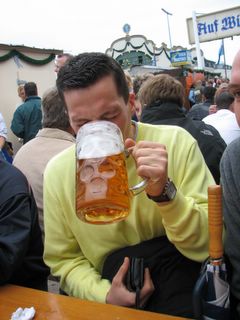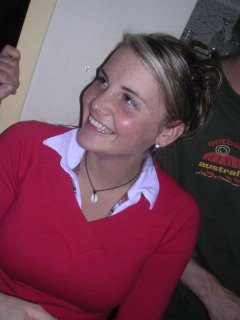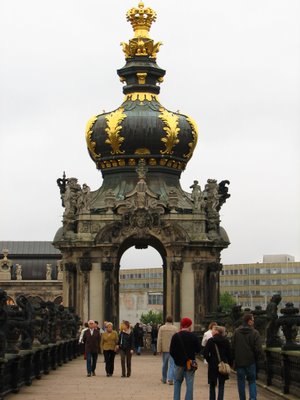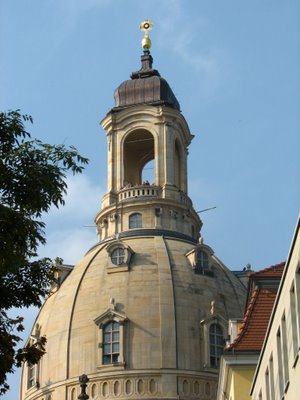Well, with the Munich weekend looking more and more like a disaster, Germany yet again is full of surprises.
After a flurry of changed plans to try and get closer to the Oktoberfest-packed Munich despite total lack of accommodation, Marko came to the rescue. Friday 30th Sept we trained it from Fuessen (goodbye to the Bavarian Alps, now topped with snow) to Augsberg, about 80km west of Munich.

Augsburg, home of the wealthy Fuggers
Probably the highlight, and later the most frustrating thing about the train ride from Fuessen to Augsburg was that on the final leg, a delightfully smiley girl sat next to Sharon and started chatting. I could not pick her accent, and couldn't believe it when she said she was German. After the usual exchange of info regarding nationalities and locations she mentioned "Oh, Australia...that's where I learned to speak English! In Adelaide, actually". When we got off the train she showed us where to stash our bags and gave some directions etc. She was unbelievably smiley, happy and helpful, when we said "Danke", she even curtsied with the longest, sweetest and slightly tounge- in- cheek "Bitte schön..!".
 Augsburg Rathaus (town hall). That's a pine cone on top, some kind of ancient fertility symbol. Whatever.
Augsburg Rathaus (town hall). That's a pine cone on top, some kind of ancient fertility symbol. Whatever.Frustrating? We didn't even get her name or pop into her workplace (a local travel agent) later to say "see ya". We walked past the office once and saw that she was busily taking calls, still wearing a huge smile. I remember Marko and Katja once expressing their concern that we would be put off by seeing how "cold" some Germans can be.
Is it just our good fortune, that the majority of Germans we encountered, have only been kind-hearted and friendly people?

The Fuggers
We wandered around the big and beautiful Altstadt of Augsburg while the tourism office tried to find accommodation. The usual squares and massive churches were consumed, as were some statues of people called the Fuggers who were local Catholic Philathropists. They are affectionately known as the Wealthy Fuggers. Apparently these wealthy fuggers were everywhere.
Meanwhile, the tourist office managed to find us some acccomodation- another 30km west (in the opposite direction from Munich). We got a room in an empty hotel in a town with absolutely nothing (correction, it had a brewery, but there were no people) I think it was called Ustersbach. The hotel/ Pension was lovely, but we were the only guests and I feared the landlord was some kind of German Norman Bates. I wished again that we had visited our mystery friend.
Still, it was the only way to see Marko and Betty again in Munich at Oktoberfest, albeit just to sample the atmosphere rather than get into the impossibly packed beer tents. We trained it into Munich on Saturday the 1st, where Marko promised us that "we would find them" at the massive, crowded Hauptbahnhof. It occured to me, as we lugged our backpacks through the Oktoberfest crush, if we could survive this, we could survive anything.
Sure enough, there was Marko and Betty with friends Sylvio and Katja, with a big "Welcome Patrick and Sharon" sign, complete with picture of Kangaroo drinking beer. Nice touch and lovingly done!

Quite a good caricature of me
Oktoberfest was, um, interesting. We managed to score a table (they don´t serve beer unless you have a seat. You are not officially taking part in Oktoberfest until you are sitting down, and of course later, falling over).
But Oktoberfest began pretty much the moment we caught the train from Augbsurg. All men were in Leiderheusen, and girls were in the tradition Bavarian dirndl complete with cute pigtails, but this wasn't the only thing that made Sharon and I stand out like sore thumbs- we weren't clutching bottles of beer either. I wondered if this was the only public event where Germans come out to drink en masse? What about football games and Grands Prix? In Australia, we use any public event as an excuse to get drunk.

Marko gets into the Oktoberfest spirit...

Despite the fact...

...that he's a teetotaller

I, however, am not...
As if Marko and Betty's assistance wasn't enough, our Saturday night accommodation problem was solvered, with friends Sylvio and Katja offering us the spare room at their apartment, evicting Marko and Betty to the couch. After Oktoberfest we headed for central Munich. The weather was foul so it was a short afternoon. But I reckon the best part was the evening.

lucky they have these leaning poles placed around Oktoberfest
 Beginner's guide to Oktoberfest:1) drink beer 2) drink more beer 3) fill up on beer 4) go on stupid fairground ride 5) throw up 6) drink more beer 7) repeat process from 1)
Beginner's guide to Oktoberfest:1) drink beer 2) drink more beer 3) fill up on beer 4) go on stupid fairground ride 5) throw up 6) drink more beer 7) repeat process from 1)After supermarket shopping for supplies, back at the apartment the guys prepared us a traditional Bavarian meal of Bratwurst and Sauerkraut. Guten appetit! Marko then found a web site with voice software. It audibly spoke whatever words you would type into the screen. So, the rest of the evening was spent with us giggling like schoolchildren as we typed in all sorts of (sometimes bawdy) things and listened to it repeated by a robotic voice.
Cold, hard Germans indeed.


These Germans drink some weird stuff...I thought it was an ice cream cone
With more foul weather (only the first we had experienced in the whole trip) we cruised around Munich, taking in all the sights from Silvio and Katja's minivan. It included the BMW museum, Allianz stadium (site of World Cup 2006) and the 1972 Olympic Village, scene of the first ever Palestinian attack on Israeli citizens where 11 Israeli athletes died. Sylvio mentioned the yet-to-be-released movie by Speilberg on the subject was getting big press in this town. I was disappointed to later discover the movie was a poor representation of the actual events.

When fed up with Churches, Art Galleries and Beer Drinking in Munich, there's always this- the REAL pride of Bavaria!
BAHNSTORMING TO DRESDEN AND CLAUDIA
With poor Claudi and Jörg unable to come to Munich and drive us back to Dresden, the next problem was the expensive prospect of the train ride from Munich to Dresden. Again, Marko was the hero. He rang some Dresdner friends who were driving back on Sunday after Oktoberfesting. I cannot question enough....what would these travels be like without such people?
Although the time with Marko and Betty was precious and too short, I was anxious to start phase 2 of the trip; Dresden, a city I have learned to love before seeing, and to be reunited with Claudia after almost two years. From her texts I gathered she was as excited to see us as vice versa. We have all been waiting for what has seemed like forever since our travel plans were made in March and she then found out she was sick only days later. Of course, in our most negative moments we feared we would never see her again. A great friendship had been struck up over those two years. So neither of us cared what time of the evening we would arrive, as long as we arrived.
It is a long way from Munich to Dresden (around 450km I think). We grabbed a bite at Pizza Hut, across from the Olympic Village, to escape the Munich rain and wait for the ride Marko had arranged. Sebastian and Kathleen rocked up at 5.30pm. Sebastian had been enjoying Oktoberfest, so, Kathleen would be driving, natürlich.
I thought it would be forever before we would arrive in Dresden, to see this long-awaited treasure of a city and greet our beloved little cancer survivor. But I forgot, this was Germany. All you need is a piece of autobahn, a German driver, and a deadline. In Australia this drive would take a tedious (and dangerous) five hours. We arrived in Dresden just after 9pm.
Sebastian mobiled Claudia to arrange a meeting point- Hochschulstrasse, just south of the Dresden Hauptbahnhof, out the front of the Technical School of the Dresden University. This was where the original "MCG footynight" gang Claudia, Marko, Jana, Sophie, Katja et al all first met and studied. This was where we waited for Claudia. Apart from paying them a miniscule fee for petrol, we gave Kathleen and Sebastian a couple of spare koalas we had in our stash, which they appreciated. Plus I made a point of telling Kathleen that she was a female Michael Schumacher and I was extremely impressed. Because I was!
So began phase 2 of our trip as Claudi and her tall bespectacled boyfriend Joerg arrived with Claudi half out the door before the Subaru wagon had even stopped. It was the same excitement we felt from being in Germany for the first time, all over again. Maybe even more so. Seeing the waify little survivor and giving her a big, long hug was more special and memorable than 3 laps of the ´Ring. Yes, you can quote me on that (I have no choice- it´s in writing!)
Our happy little band then drove off in the night, to Claudi´s little town of Seifersdorf, a gorgeous little hamlet in the rolling hills which in wintertime must look like one of those snowglobe towns. Dresden sightseeing would have to wait until morning. Her parents don't speak english, but that was half the fun, as we chatted about Australia, the footynight, Kangaroos, GDR and Trabants, then off to bed.
DRESDEN
Having spent all time thus far in "West" Germany, this was our first look at the former east. The urban differences between the two (theoretically) reunited Germanys are very clear. Diluting the classic German architecture is Communist developed mass density unit housing. There were parks overgrown and unkempt, graffiti and abandoned buildings. Only 16 years ago this was a totally different country. And it shows. But I absolutely love it. This is the Germany I came to see, and nobody denies that the differences are still there, visually and economically.

Tourist waiting for that elusive tourist-less photo, Zwinger
Thanks to Cam lending me a book of the same name, representing the most authoritative, sympathetic yet realistic and poetically written account of the 1945 allied attacks on Dresden, it was hard not to look at the sights of the old historic section, without feeling a lump in your throat. Despite the military justifications of the attack (which there were, contrary to popular, and Soviet propagated, belief) you hear a little voice saying "what did we do?"
The massive Frauenkirche (Church of Our Lady), still under privately-funded econstruction was the most poignant symbol. On February 14th, 1945, after twin firebomb midnight attacks (which were described as "the operation which went horribly right"), terrorized and shocked Dresdners surveyed their destroyed and burning city.
They were able to take some solace that their battered skyline at least retained the proud, 300 foot- high shape of the Frauenkirche. The ancient, solid structure withstood the potent explosives, bombs had literally bounced off the surface. But the surrounding high temperatures weakened the iron and timber sub-structure, and at 10.45am on the Thursday after the Tuesday-night attacks, the last remaining piece of Dresden skyline collapsed into rubble.

Florence on the Elbe
The Soviets left it that way for 40 years. After the Iron Curtain fell, a plethora of private and corporate donations lead to a triumphant rebuilding, and we were privaleged to see the culmination of that. It is mostly a "reproduction". It stands out with bright, fresh stonework, but dotted with distinctive dark block sections, being some of the original stones. With the aid of computer software, what original stonework could be salvaged was relocated in the exact place from whence it came.
The stories of world generosity in the rebuilding effort are far and many. The golden cross atop the Frauenkirche was personally crafted by the son of a WWII bomber pilot who took part in the raids. But bookstores and postcards everywhere here remind us of the bombing of Dresden.
Claudi's grandmother recounts sitting in her house in Seifersdorf (across the courtyard from Claudi's where we are staying) during the raids. She said she was able to read the newspaper. I think this is an unremarkable statement, until I realise what she meant. It was midnight, there was total blackout, she could read the newspaper from the orange glow 15 miles away.
I hope that here the feeling of reconcilliation and progress encompasses any feelings of bitterness. Of course I feel sorry for the Dresdeners who endured this, the lives lost, and of course it's terrible that so many beautiful things were destroyed. But of course nobody should apologise. It was war. It's over now. The reconstruction of Dresden, and particularly the Frauenkirche, is a great symbol of "moving on". Unfortunately, the memory is occasionally used by neo-nazis and anti-west groups for propaganda. Nothing new there- the Soviets' approved of the bombing to help end the war and give them a slice of the takings. Then when they ruled the area, they told East Germans look at what the West did to your beautiful city. Aren't they evil?
Well, if there's one thing we learn from history, it's that we learn nothing from history.
All of the magnificent, stately and massive baroque buildings, surviving or rebuilt, are a characteristic combination of black stone, emerald green spires and dazzling golden ornaments. It´s not until you look closely that you realise that the blackness of the stonework is not old, quaint discolouration from age, but the permanent scars of a 1000-degree firestorm.
After the Altstadt we ventured out along the Elbe to Schloss Pillnitz, a colourful Dresden riverside landmark. Here Claudi and Joergy treated us to a local delicacy- Pulsnitzer Chokoladenspitzen (I think), soft gingerbread, chocolate coated, with jam filling. We may be attempting to import some to Australia very shortly- it was wickedly yummy.
Call me an old softie (preferably leave out the "old") or sentamentalist: to walk through the city of Dresden is a poignant and moving experience.

But our experience today was brightened by the happy face of Claudia, wearing a perpetual smile from ear to ear. It´s a pleasure to see her again. She only looks frail, but doesn´t act it. As demanding, sightseeing tourists, we will try not to wear her out over the next few days.









